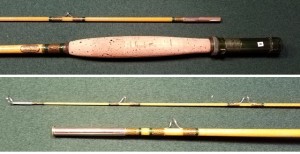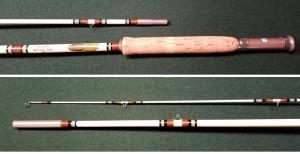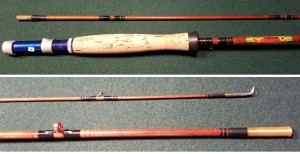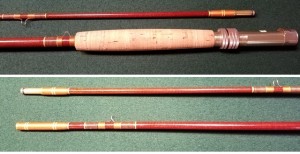4-Shakespeare, Conolon, & Sili-Flex
Howald and Havens started the fiberglass fly rod industry. I will start with a description of their rods in the collection, and add Sili-Flex because it was an early offshoot of Haven’s Conolon.
This first rod is a Shakespeare Wonder Rod model 1250 made in January 1953 (FHK date code). It is 8’6” rod intended for an HCH line, though the length and line size are not labeled. The down-locking reel seat and butt-over-tip metal ferrule are standard for the time. The Howald process started by placing fiberglass fibers over a balsa wood mandrel which remained in the finished rod. This rod feels a little heavy in hand and flexes at the ferrule when casting. I question the variegated thread wraps as being original, only because of the thread. In all other respects, the wraps look original.
The second rod is a Shakespeare Wonder Rod model 1290 Presidential made in April 1960 (FAG date code). It too is an 8’6” HCH rod. The Presidential is a more expensive rod that sold for $50. The wraps are more complex, and the reel seat is up-locking spring loaded. The end would be pulled out to accept the reel, and spring tension would hold the reel in place. Up-locking was rarely used on fiberglass rods, and the spring seat didn’t catch on in the industry. Shakespeare had started using removable metal mandrels by the time this rod was made, and in this case, produced a flawless white finish. It is lighter, flexes halfway between the tip and ferrule. It is faster and performs better than the 1250 model. There is no reason not to fish this rod today, 58 years after it was made.
Shakespeare was in the fishing business in 1905 and still is. Its first fiberglass rod was on the market in 1945 or 46. It did not spin off other manufacturers as did Conolon. In 1951 Shakespeare received a patent for fiberglass rods, and 1952 licensed the patent to 34 other manufactures for $1 each. Shakespeare allowed others to continue the development of fiberglass rod technology, and they are still in business today, while most of the 34 others are not.
Conolon was started by Glenn Havens in Costa Mesa, California at the same time as Shakespeare in Columbia, South Carolina. Conolon wrapped fiberglass fabric around a steel mandrel. This became, and still is, the standard process for fly rod manufacture. The fly rod and hollow tube industry today is largely a result of the process developed by Glenn Havens, whose rods went on the market in 1946. It is debated which company was first, Shakespeare or Conolon.
The Conolon Live Fiber 6105 is a 6’3” rod without a line designation. It has a standard reel seat and a high-quality butt-over-tip ferrule. Note the front of the grip has a non-cork ring, and the stripping guide is agate. I was initially surprised to find a 6-foot rod, but have since learned the many fiberglass manufactures sold a short rod. They were much more popular in the fiberglass era than today. This rod is light, tip flex, and fast action for fiberglass and casts a 6/7 weight line.
The Conolon 7100-8 Falcon rod appeared in the 1955 catalog just below their top-end rod. It is an 8” HDH (6 weight). It is the same quality as the model 6105, and it is lighter than the Shakespeare Wonder Rods and easier casting. It is a mid-tip flex rod that would be pleasant to fish today.
I have included Sili-Flex in this group because it was formed in 1952 as the first spinoff from Conolon. It’s contribution to technology was curing rods in a pressurized bag. This produced a stronger and lighter wall thickness that had a smoother finish. This rod sold for $75, which reflects its quality. Note the reel seat, wraps, and Super Z ferrule. It is 8’6” 7 or 8 wt. It casts 7 well but is much better with 8wt.
Thread wrapping quality on this Sili-Flex and the Shakespeare Presidential is unsurpassed, most particularly today. It can only be found on completely custom rods if at all.
[print_link]






You write: “In 1951 Shakespeare received a patent for fiberglass rods, and 1952 licensed the patent to 34 other manufactures for $1 each.”
I would love to learn more about this, such as who the 34 companies were. What source materials (references/citations) do you have for your statement? That could help lead me to more information (which I certainly would share).
In regard to patent awarded in 1951, are you referring to US2571717 Howald et al. “Shaft for Fishing Rods” (or something else)? If so, that patent appears to belong to Howald & Meyer assignors to Libbey-Owens-Ford Glass Company – not Shakespeare.
Thanks for your blog!
I’m out of town for a couple of weeks, but will reply with details soon.
John,
My information comes from Victor Johnson’s book, “Fiberglass Fly Rods”. In it, he writes that the patent rights were offered to Horrocks-Ibbotson and 34 others by Libby-Owens and Shakespeare. Shakespeare continued to be the only company allowed to build rods using the Howald process. There was also a removable steel mandrel patent (Scott 2,749,643) which may have been involved. To Shakespeare’s credit, they did not try to use the patent to limit fiberglass technology development. I assume the 34 manufacturers were all those in business at the time.